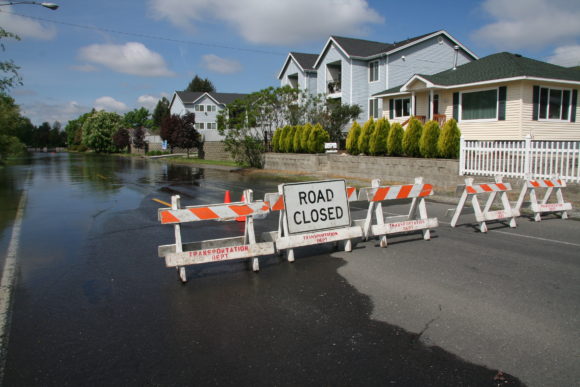Coastal communities across the U.S. again experienced increased high tide flooding last year, forcing their residents to deal with flooded shorelines, streets and basements. The elevated water levels affected coastal economies, tourism and infrastructure like septic systems and stormwater systems, according to a new report from the National Oceanic and Atmospheric Administration (NOAA).
The report warns that annual flood records are expected to be broken again next year and for years and decades to come from rising sea levels.
The report, 2018 State of High Tide Flooding and 2019 Outlook, documents changes in high tide flooding patterns at 98 NOAA tidal gauges along the U.S. coast that are likely to continue in the coming years. NOAA’s tide gauge observations provide information about changes in coastal flood risk to help communities plan.
High tide flooding, often referred to as “nuisance” or “sunny day” flooding, is increasingly common due to years of relative sea level increases. It no longer takes a strong storm or a hurricane to cause flooding in many coastal areas, according to NOAA.
“U.S. coastal communities are faced with mounting challenges as sea levels rise,” says Nicole LeBoeuf, acting director of NOAA’s National Ocean Service.
According to the report, nationally in 2018, five days of high tide flooding occurred within coastal communities, tying the record for the median set in 2015. Flood days broke records in the Northeast, with a median of 10 days, and the Eastern Gulf of Mexico at five days, due to a combination of active nor’easter and hurricane seasons combined with sea level rise.
The flooding was most prevalent along the Northeast Atlantic Coasts (median of 10 days) and broke records within the Chesapeake Bay (22 days in Washington D.C. and 12 days in Annapolis and Baltimore) and along the Eastern Gulf of Mexico Coasts with some major flooding from several hurricanes. In all, 12 individual (out of 98 U.S. tide gauge) locations broke or tied their high tide flood records.
NOAA has identified more than 40 locations where annual rates of high tide flooding are rapidly increasing. Annual rates at 25 other locations are also trending upwards but more gradually. These increases suggest a much wetter future for many coastal areas.
High tide flooding in 2019 is projected to be higher than normal at about 40 locations along the U.S. West and East Coasts in part due to a minor El Niño that is predicted to persist until early next year. Regionally in 2019, the Northeast Atlantic is projected to experience a median of 8 days of flooding. Flooding along the Southeast (5 days), Eastern Gulf (3 days) and Western Gulf (6 days). The U.S. Southwest and Northwest Pacific Coasts are projected to see a median 2 and 6 days of flooding, respectively.
“Once communities realize they are susceptible to high tide flooding, they need to begin to address the impacts, which can become chronic rather quickly,” said William Sweet, Ph.D., an oceanographer for NOAA’s Center for Operational Oceanographic Products and Services and lead author of the report. “Communities find themselves not knowing what to expect next year and the decades to come, which makes planning difficult. Our high tide projections can play a vital role in helping them plan mitigation and other remedies.”
By 2030, long-term projections show 7 to 15 days of high-tide flooding nationally. By 2050, the number rises to 25 to 75 days.
NOAA maintains ocean observing infrastructure, including more than 200 permanent water level stations on the U.S. coasts and Great Lakes.
Source: NOAA
Was this article valuable?
Here are more articles you may enjoy.



 Beware of Hidden Email Addresses: TN School Transferred $3M to Fake Account
Beware of Hidden Email Addresses: TN School Transferred $3M to Fake Account  Appeals Court Spikes Brett Favre’s Defamation Suit Against Shannon Sharpe
Appeals Court Spikes Brett Favre’s Defamation Suit Against Shannon Sharpe  Study Stirs Debate on Real Impact of Litigation, Fraud on Property Insurance
Study Stirs Debate on Real Impact of Litigation, Fraud on Property Insurance  Flooding in Central Europe Could Cause Billions in Economic Losses, Analysts Say
Flooding in Central Europe Could Cause Billions in Economic Losses, Analysts Say 

